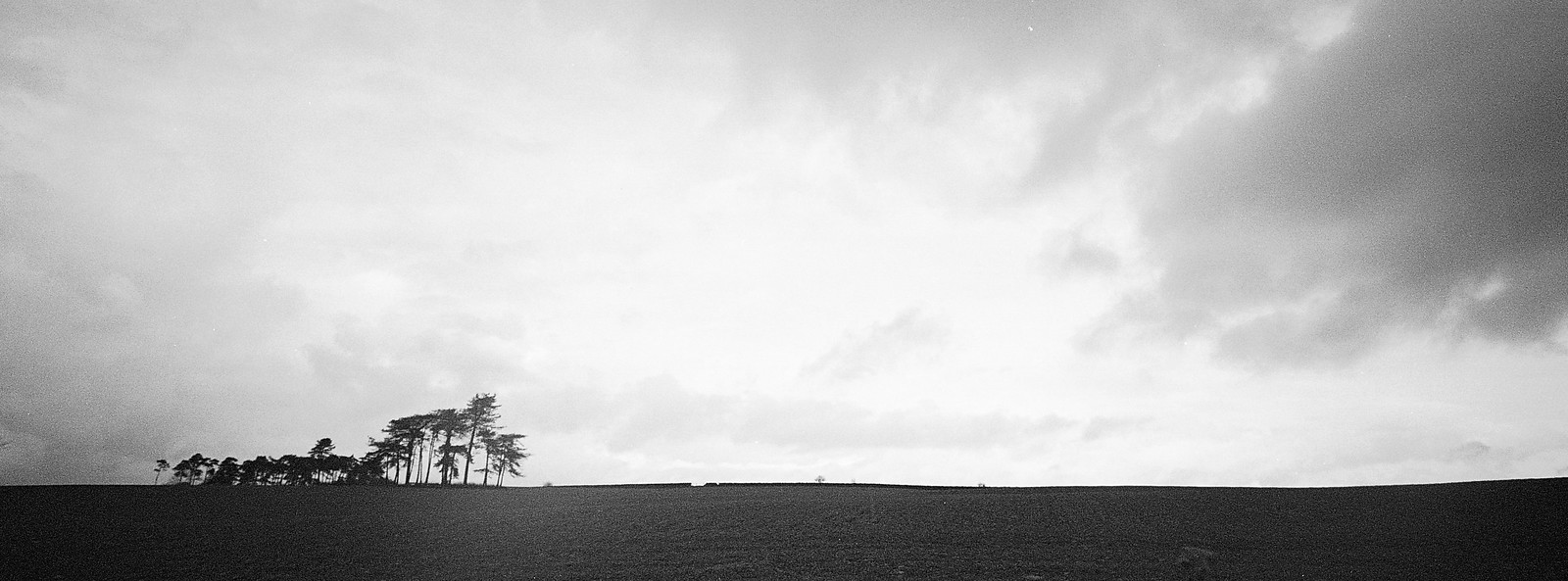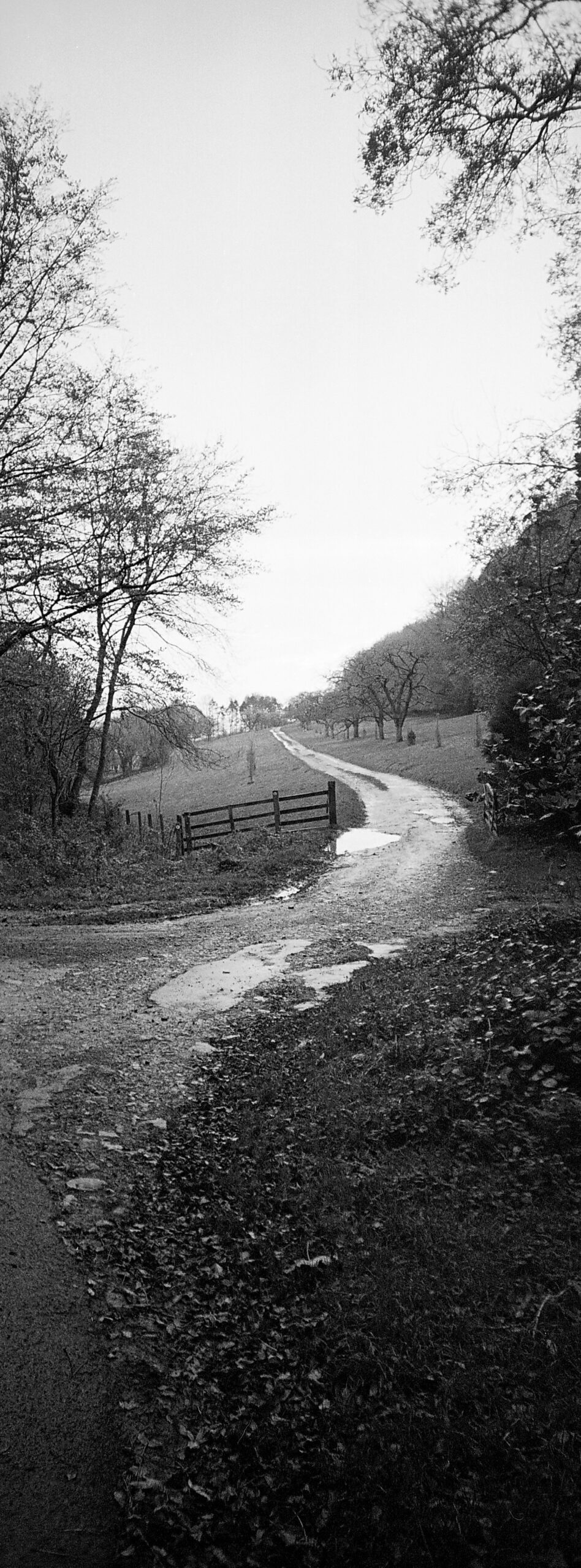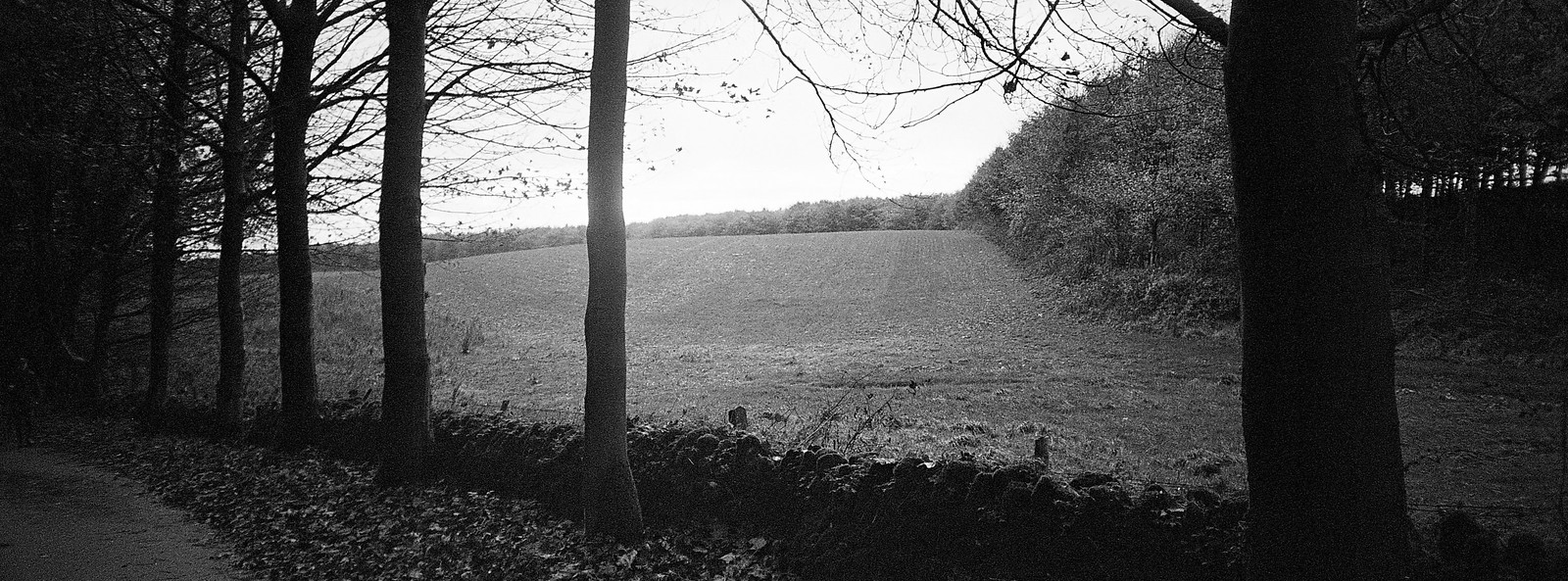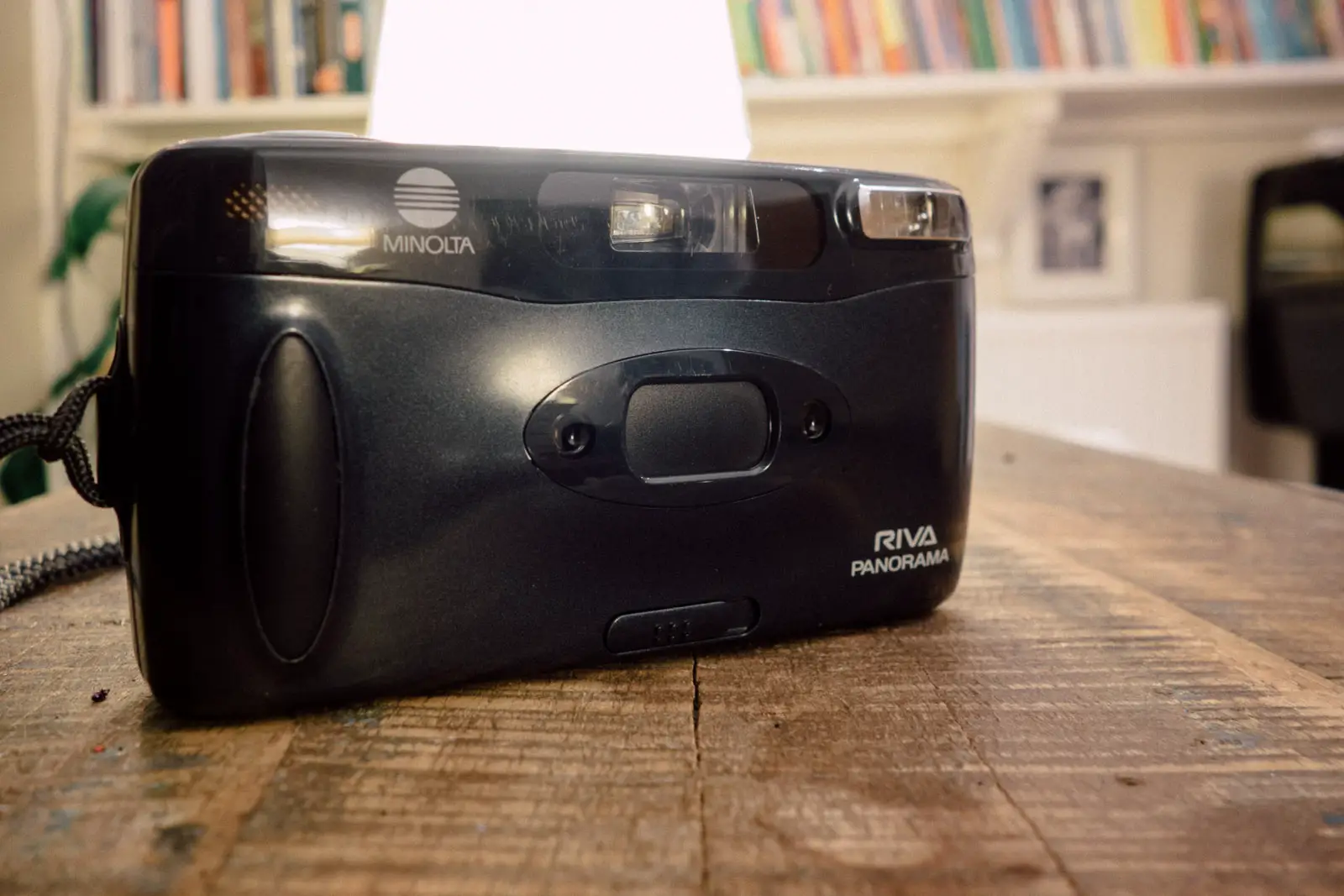If I pick up a camera with a panorama switch on it – a switch that blacks out the top and bottom of the viewfinder and flaps in some plastic panels to partially block the film gate – I will never switch the switch! Why would I? What could I possibly gain from loosing such a significant amount of negative? That being my mentality, it might surprise you to read that I bloody love the Minolta Riva Panorama, a camera that not only crops the top and bottom of the normal 35mm 3:2 frame to 2.7:1, but doesn’t actually allow full frame shooting at all!
What perhaps might make appreciation of this camera even more odd to some, is that along side this cropping of the frame, it’s also a very simple point & shoot with very few features, basic specifications and a fairly slow lens. The thing is though, sometimes it only takes one feature or specification, that whilst on the surface might seem fairly insignificant, actually makes a camera a complete joy to use. And in the case of the Minolta Riva Panorama, that one thing is its viewfinder.

Ordinarily, if I were to rave about a viewfinder it would be for technical reasons, such as it being very bright, having a good set of useful info on display or even just big. Well it is definitely big! Whilst on cameras that have a panoramic mode the normal viewfinder is cropped meaning that the letter-box shape you frame with is tiny. The Minolta Riva Panorama’s viewfinder takes the average height of a compact camera viewfinder and adds the width required to frame a panoramic. What results is a viewfinder that feels actually fairly huge, at least by compact camera standard, and especially by cheap point and shoot compact camera standards.I guess the idea that a panoramic camera would have a panoramic viewfinder is pretty obvious really… But what I’ve found results from this size and shape is something much greater than these technical specifications. What this large dedicated viewfinder gives me is a change of mindset. Presented with no option to shoot full frame, by a viewfinder that doesn’t feel like a cropped afterthought, the camera feels as though it is giving me a new, previously unexplored compositional challenge … And I like it!
This challenge somehow completely removes any worries about the idea that I’m shooting a camera that is wasting large parts of a the normal area of negative. When I put the large viewfinder to my eye, I am shooting a wide panoramic frame, and composing for that is the only thing going through my mind. Admittedly the slightly vague framing lines that disappear faced with any real light source are a little bit annoying, and the complete lack of useful feedback from the camera in the viewfinder might be a bit disconcerting to some. But even those shortcomings are forgiven in my world due to the joy of shooting within different compositional constraints to those that I am used to.
Minolta Riva Panorama – Lens and photos
The Minolta Riva Panorama sports a 24mm 4.5 lens, which on face value, though wide, is obviously fairly slow. I shall touch on why I don’t think the lenses speed is an issue in a mo. It is also worth pointing out that there are very few cameras of this size that have lenses as wide or even as fast.
The photos this camera takes are by no means perfect. Close-ish inspection of the edges of the frame will reveal some serious coma problems. The fall off to the issue is quite sudden, but quite drastic. As far as I know though – from talking to Jinny in my D&P – this part of the negative wouldn’t be printed, at least at a high street D&P. Apparently there is a small amount of cropping that happens, and I suspect it would crop out a large part of the issue. Of course for my purposes this is moot, as I very rarely print on the high street, but it does perhaps mean that in this cameras day the people shooting it would have been largely unaware of the “problem”.
The lens also vignettes and although is fairly sharp is not notably so, in fact technically speaking it isn’t a particularly amazing lens at all. But actually for me, despite the lens not being especially great by convention, the photos have real appeal. I might just be suckered in by the shape of the frame to some extent, but to my eye there is something more to the lenses character that makes for very aesthetically appealing photos.
As you can probably tell, I like this camera. But I should point out, it isn’t without its limitations. In fact, it’s actually probably one of the most limited cameras I own.

Specifications
The Minolta Riva Panorama’s specs limit it quite drastically. The first point of note is that the lens close focuses to 0.9m – that’s not that close for a 24mm lens. Though being used to RF lenses, I haven’t found it an issue particularly. It’s metering range is also pretty limited at 7ev – 17ev (100iso). Combine this with its DX code reading only going up to 400iso and you have a camera that, outside of use of the flash, is only really any good for shooting in the daytime. But this fact is really why I’m not worried about its relatively slow f/4.5 lens. If it had a 1.9 lens and was still near useless in lower light it would feel frustrating, but since all the signs point to only using this camera in daylight, or with its flash (in my case, specifically just in daylight), it’s easy to accept it as just a daylight camera.
Features and the Minolta Riva Panorama in use
The Minolta Riva Panorama is a tiny camera, yet it feels more than comfortable to use. I haven’t had any issue with my fingers getting in the way of the lens, my eye finds he finder very easily and it feels plenty responsive enough. It’s biggest short fall is perhaps the near complete lack of feedback it gives. Half press the button and a little green light does illuminate, but as the manual reports this is to “show the focus has been set, and in the case of the flash being used to confirm it has been charged”. This might sound as though it could be useful, but in practice the focus is set every time you half press the button. Even if I put my hand over the front of the camera blocking any chance of it focusing on something, it still confirms “the focus has been set”. I can only assume it defaults to infinity or a hyperfocal distance if it can’t find focus, as shooting the landscapes I have, I’ve not had any issues even when pointing it at a flat grey sky.
The only time this light doesn’t illuminate is before the flash is charged just after the camera is fired with flash. Once charged though, it just lights up green again, giving no indication of whether or not the flash is going to fire. If you have any concern that it might, and you don’t want it to, there is a button on the top of the camera that if held down will prevent it from firing. I actually quite like this always auto, unless overridden approach to flash control. It’s a lot quicker than having to press a menu button a few times to switch it off every time. It’s a feature shared with a lot of Ricohs and the Nikon 35ti. Perhaps surprisingly, the Nikon is the only camera that doesn’t feel like a successful function, as by having the button in an awkward place on the front, it’s more fiddly than useful. I digress a touch. Even with this nicely implemented flash control, it is still pretty clear that flash photography isn’t a forte of this camera, as auto, or forced off are the only options.
It also has a self timer, which since the camera goes down to 7ev(100) means that with its 4.5 lens, its lowest shutter speed is 1/2sec. Of course since there is no way to ensure the flash won’t fire without holding a finger on the top of the camera, actually taking advantage of this level of low-ish light capability would need a fairly solid tripod.

So what’s the verdict on the Minolta Riva Panorama
In short, this really is a very basic camera indeed. It’s clearly designed pretty much exclusively for shooting landscape photos in the daytime/early evening. If you want it for anything other than that, I probably wouldn’t bother with it. If you want perfect, highly detailed, clinically good photos, I wouldn’t bother with it. If you are looking to feel like you have complete control over the camera, well I certainly wouldn’t bother with it. But if you are looking for something relatively inexpensive that will challenge your compositional skills, give you the opportunity to shoot the world in a different way and all in something that will fit in even the smallest of pockets, you might well find this camera as enjoyable to use as I do.
I must admit that I’m almost certain that a portion of my current enthusiasm for it is based on the novelty factor, but even taking that novelty out of the equation, it still offers me a user experience that is unique to my camera collection. So for for me, even only a couple of films in to using it, I know this is a camera I shall be keeping hold of!
You can find a few more shots I’ve taken here on flickr
Cheers for reading
Hamish
Share this post:









Comments
Urban Hafner on Minolta Riva Panorama Review – A simple joy!
Comment posted: 19/11/2014
This really is a keeper, and I will definitely use it time and time again. My results will be available here: http://urbanhafnerphotography.com/blog/?tag=minolta riva panorama
Comment posted: 19/11/2014
Comment posted: 19/11/2014
Rob on Minolta Riva Panorama Review – A simple joy!
Comment posted: 19/11/2014
Rob
Comment posted: 19/11/2014
Comment posted: 19/11/2014
Comment posted: 19/11/2014
Charlotte on Minolta Riva Panorama Review – A simple joy!
Comment posted: 20/11/2014
The only problem is, it chews through batteries! And the settings are a little bit weird, for example it takes at least 3 presses through menus to just turn off the auto flash... great little camera though, with a nice sharp lens.
Comment posted: 20/11/2014
Archiver on Minolta Riva Panorama Review – A simple joy!
Comment posted: 04/12/2014
The Land of the Cameras of the Dead - mike eckman dot com on Minolta Riva Panorama Review – A simple joy!
Comment posted: 31/10/2018